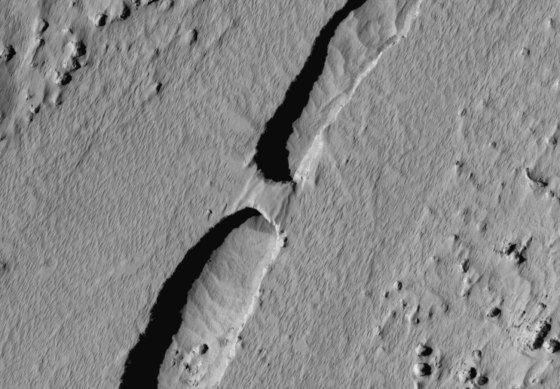A thin channel on Mars has a naturally occurring bridge over it, as seen in an image from the Mars Reconnaissance Orbiter's High Resolution Imaging Science Experiment camera, or HiRISE. The channel runs through a stretch of knobby terrain called Tartarus Colles.
The origin of the channel itself is unknown, Kelly Kolb from the HiRISE team said in an image advisory, though it was probably not formed by running water as there are no obvious source or deposit regions. "The channel is probably a collapse feature," she wrote.
The bridge itself is "probably a remnant of the original surface," Kolb added. She noted that a depression extending northward from the channel, but not as deep as the majority of the channel, might be in the process of collapsing and enlarging the chasm.
When the image first came to light several years ago, the Planetary Society's Emily Lakdawalla speculated that the channel likely started as a covered lava tube, but that most of the roof has collapsed over time. The remnant left behind bridges the gap. In time, that remnant will most likely fall into the channel as well. That's what happens to natural bridges on Earth.
Bridges also abound on the moon, and you can check them out in 3-D. These features were captured by NASA's Lunar Reconnaissance Orbiter Camera -- and, like the bridge on Mars, were left behind when the surrounding material on the surface fell into a chasm.
Tip o' the log to Universe Today's Nancy Atkinson.
John Roach is a contributing writer for msnbc.com. Connect with the Cosmic Log community by hitting the "like" button on the Cosmic Log Facebook page or following msnbc.com's science editor, Alan Boyle, on Twitter (@b0yle).
